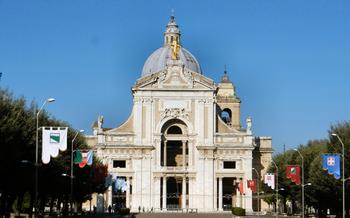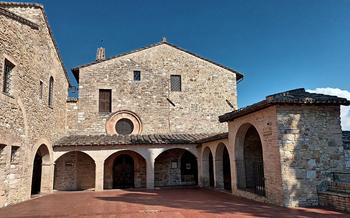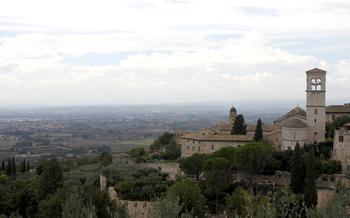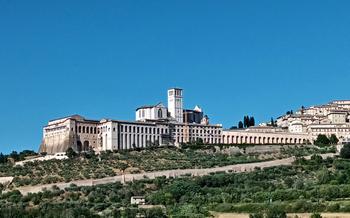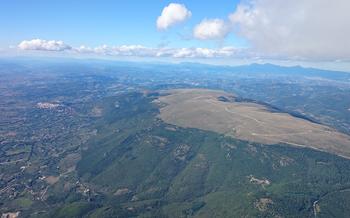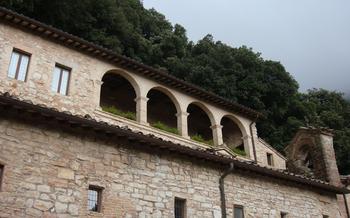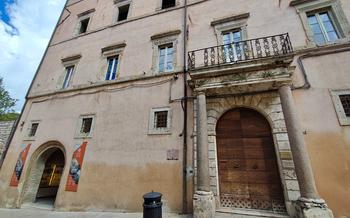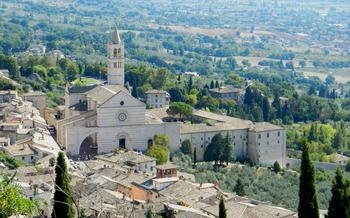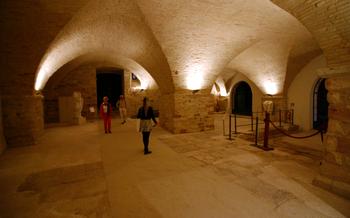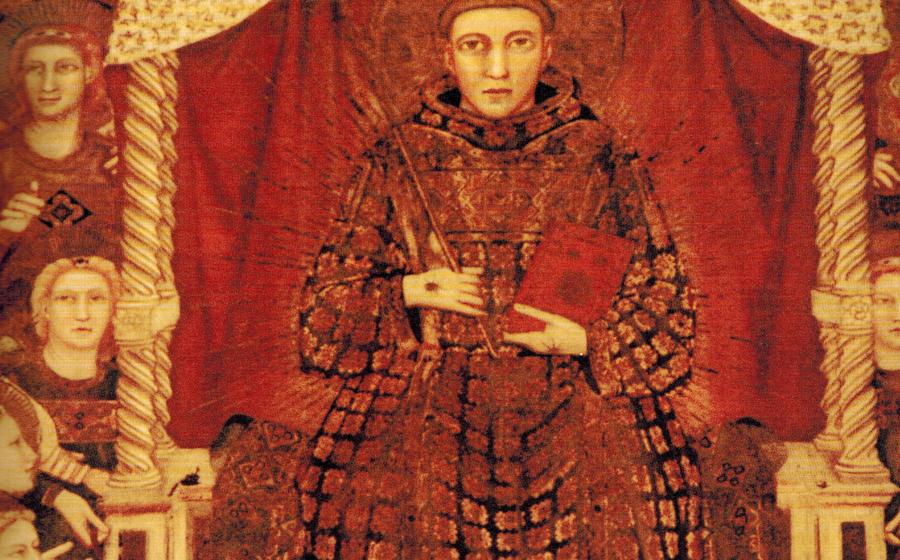
Casa di Giotto
- Assisi, an Umbrian Gem
- Casa di Giotto - A Masterpiece of the Renaissance
- Exploring the House of Giotto
- The Life of St. Francis in Fresco
- The Miracle of the Stigmata
- The Meeting of St. Francis with the Sultan
- The Obsequies of St. Francis
- Appreciating Giotto's Technique
- Casa di Giotto in the Footsteps of St. Francis
- Assisi as a Pilgrimage Destination
- Local Cuisine and Accommodation
- Tips for a Meaningful Visit
- Casa di Giotto for Art Enthusiasts
- Photography and Social Media
- Insider Tip - Off-the-Beaten-Path Gems
Assisi, an Umbrian Gem
Nestled in the heart of Umbria, the picturesque hilltop town of Assisi beckons travelers with its rich history, cultural significance, and breathtaking landscapes. In ancient times, Assisi's strategic position made it a coveted prize, while in the 13th century, it became the birthplace of one of the most revered figures in Christianity - St. Francis. Today, Assisi stands as a UNESCO World Heritage Site, drawing pilgrims and tourists alike to its hallowed grounds. With its cobblestone streets, medieval architecture, and a palpable sense of spirituality, Assisi invites visitors to immerse themselves in the life and legacy of its patron saint and discover the timeless beauty of this Umbrian gem.
Practical Information:
- Location: Central Italy, nestled amidst the Apennines and the Tiber Valley.
- Best Time to Visit: Spring (April-May) and fall (September-October) offer pleasant weather, fewer crowds, and a vibrant ambiance.
Casa di Giotto - A Masterpiece of the Renaissance
The Casa di Giotto stands as a testament to the artistic prowess of the renowned Renaissance master, Giotto di Bondone. Commissioned by the Franciscans in the early 14th century, this remarkable edifice served as a residence for Giotto while he worked on his groundbreaking frescoes in the nearby Basilica of San Francesco.
Giotto, a pioneer of the Renaissance movement, revolutionized the art world with his innovative techniques and naturalism. His frescoes in Assisi, characterized by their emotional depth and spatial realism, would profoundly influence the course of Western art.
The Casa di Giotto is situated in the heart of Assisi, just a short walk from the Basilica of San Francesco. Visitors can immerse themselves in the history and artistry of this unique dwelling, which has been meticulously preserved and restored to its former glory. Guided tours are available, providing insights into Giotto's life, work, and the significance of this architectural gem.
Exploring the House of Giotto
The Casa di Giotto stands as a testament to the evolution of architectural design and the enduring legacy of St. Francis. Constructed in the 14th century, the house underwent several modifications over time, reflecting the changing needs and tastes of its occupants.
Originally built as a simple two-story structure, the house showcases a blend of Romanesque and Gothic architectural elements. The exterior features sturdy stone walls, arched windows, and a prominent entrance portal adorned with intricate carvings.
Inside, visitors are greeted by a series of interconnected rooms that once served various purposes. The ground floor features a spacious kitchen and living area, while the upper floor houses a more intimate study and bedroom. The layout of the house reflects the practical and functional approach to living that was prevalent during Giotto's time.
Artistic interventions, however, transform the Casa di Giotto into a masterpiece of the Renaissance. Giotto's frescoes grace the walls of the house, creating a vibrant and immersive experience for visitors. The frescoes, depicting scenes from the life of St. Francis, serve as a testament to Giotto's innovative techniques and his profound understanding of the human condition.
The Life of St. Francis in Fresco
Giotto's frescoes in the Casa di Giotto are not merely decorative; they are a profound visual narrative of St. Francis's life and spiritual journey. Each fresco depicts a key moment in the saint's life, capturing his transformation from a wealthy merchant's son to a humble follower of Christ.
One of the most striking frescoes portrays St. Francis renouncing his worldly possessions. In this scene, the young Francis, dressed in fine clothes, stands before his father, who is seated on a throne. Francis, with a determined expression, is in the act of stripping off his clothes, symbolizing his rejection of material wealth and his embrace of poverty.
Another iconic fresco shows St. Francis receiving the stigmata, the wounds of Christ. Francis, depicted with a serene expression, stands in a rocky landscape, his arms outstretched, as a seraph descends from heaven, piercing his hands, feet, and side with rays of light. This event, considered a divine revelation, marked a turning point in Francis's life, deepening his connection to Christ and his commitment to a life of humility and service.
Giotto's frescoes are not just artistic masterpieces; they are windows into the soul of St. Francis and his profound spiritual journey. They invite viewers to contemplate the saint's life and teachings, inspiring them to reflect on their own spiritual paths.
The Miracle of the Stigmata
The fresco depicting the Miracle of the Stigmata is a captivating portrayal of a profound spiritual experience in the life of St. Francis. The scene unfolds on the slopes of Mount La Verna, where St. Francis received the stigmata, the wounds of Christ. Giotto's artistic interpretation captures the essence of the event, portraying St. Francis in a state of ecstatic communion with the divine.
This fresco is an allegory of St. Francis's profound connection with Christ and his willingness to embrace suffering and sacrifice. The symbolism of the stigmata, the wounds that mirror those of Jesus, highlights the saint's identification with the Savior. Giotto's skillful use of color and composition conveys the emotional intensity of the moment, inviting viewers to contemplate the spiritual transformation undergone by St. Francis.
To fully appreciate the fresco, it is recommended to position oneself at a slight angle to gain a better perspective of its intricate details. This allows viewers to immerse themselves in the narrative and grasp the depth of emotion expressed in St. Francis's countenance and the surrounding figures.
The Meeting of St. Francis with the Sultan
In 1219, St. Francis undertook a daring journey to Egypt to meet the Sultan, Al-Malik al-Kamil. Driven by his profound desire for peace and understanding, St. Francis sought to bridge the divide between Christianity and Islam. Giotto's depiction of this encounter captures the essence of this momentous event.
The fresco portrays St. Francis and the Sultan engaged in a cordial conversation. Their figures are positioned on either side of a table, emphasizing the equality and respect that characterized their dialogue. Giotto's use of gestures is particularly noteworthy as he portrays St. Francis with his arms outstretched, a gesture of openness and sincerity. The Sultan, in turn, is depicted with his hand raised, conveying a sense of contemplation and receptiveness.
Giotto's artistic interpretation of this meeting transcends the historical narrative, becoming a symbol of interfaith dialogue and the pursuit of peace. The fresco serves as a reminder of the possibility for understanding and reconciliation, even in the midst of differences.
Practical Information: The fresco depicting the meeting of St. Francis with the Sultan can be found within the Casa di Giotto in Assisi. It is situated on the lower level of the house and is easily accessible during the museum's operating hours. To fully appreciate the fresco's historical context, consider reading up on the life of St. Francis and his mission of peacemaking.
The Obsequies of St. Francis
The final chapter of St. Francis' earthly journey is depicted with profound emotion in Giotto's fresco, "The Obsequies of St. Francis." This poignant work captures the moment of mourning and profound grief that followed the passing of the beloved saint. Giotto's masterful brushstrokes convey the deep sorrow and devotion felt by the friars and followers who gathered around the lifeless body of their spiritual leader.
The fresco portrays a solemn procession, with the friars carrying St. Francis' body through the streets of Assisi. The mourners' faces are etched with sadness, as they bid farewell to the man who had touched their lives in profound ways. The townspeople of Assisi join the procession, their expressions reflecting a shared sense of loss and reverence.
Giotto's attention to detail is evident in the intricate depiction of the mourners' garments and the architectural elements of the city. The play of light and shadow creates a sense of depth and atmosphere, immersing the viewer in the emotional intensity of the scene.
To fully appreciate the emotional depth of this fresco, visit the Casa di Giotto during the late afternoon, when the natural light casts a warm glow on the artwork. Allow yourself to be enveloped by the serene atmosphere and reflect on the profound impact that St. Francis' life and teachings have had on the world.
Appreciating Giotto's Technique
Giotto's frescoes in the Casa di Giotto are not merely decorative; they are a testament to his mastery of technique and innovation. Giotto was one of the first artists to experiment with perspective, creating the illusion of depth and realism that would become a defining characteristic of Renaissance art. His use of color is also noteworthy, with vibrant hues that bring the scenes to life. Giotto's figures are characterized by their emotional expressiveness, conveying a range of emotions from joy and wonder to sorrow and despair.
To fully appreciate Giotto's technique, take the time to observe the frescoes up close. Notice how he uses light and shadow to create depth and volume. Pay attention to the details in the figures' clothing, the landscapes, and the architectural elements. Giotto's frescoes are a treasure trove of artistic innovation, and careful observation will reveal the genius of his craft.
If you are interested in photography, be sure to bring your camera. The Casa di Giotto is a great place to practice your photography skills and capture some stunning images of Giotto's masterpieces. However, remember to be respectful of other visitors and avoid using flash photography, which can damage the frescoes.
Casa di Giotto in the Footsteps of St. Francis
In the enchanting town of Assisi, where the spirit of St. Francis permeates the air, the Casa di Giotto stands as a poignant testament to the saint's profound influence. Beyond its artistic allure, the house invites visitors to delve deeper into the life and legacy of this beloved figure.
Practical information:
- Other sites related to St. Francis in Assisi:
- Basilica di San Francesco: Explore the grand basilica that houses St. Francis' tomb and marvel at its stunning frescoes depicting his life.
- Eremo delle Carceri: Immerse yourself in the tranquility of this secluded hermitage where St. Francis sought solitude and communion with nature.
- Santuario di Rivotorto: Discover the origins of the Franciscan Order at this humble monastery, where St. Francis and his followers established their first community.
Assisi as a Pilgrimage Destination
Assisi has been a prominent pilgrimage destination for centuries, attracting believers from around the world who seek to walk in the footsteps of St. Francis. The city's spiritual atmosphere and the presence of numerous religious sites make it an ideal destination for those seeking a meaningful and contemplative journey.
Pilgrims can follow in the footsteps of St. Francis by visiting the places where he lived, prayed, and preached. The Basilica of San Francesco, with its stunning frescoes by Giotto and Cimabue, is a must-see for any pilgrim. Other significant pilgrimage sites include the Hermitage of the Carceri, where St. Francis sought solitude and contemplation, and the Basilica of Santa Chiara, where his close friend and follower, St. Clare, is buried.
Throughout the year, Assisi hosts various religious events and celebrations that attract pilgrims and visitors alike. The most famous of these is the Feast of St. Francis, which takes place on October 4th and features processions, masses, and special events throughout the city.
For those seeking a more immersive pilgrimage experience, there are several pilgrim routes that lead to Assisi. The most popular route is the Via di Francesco, which starts in Florence and winds its way through the beautiful Tuscan and Umbrian countryside before reaching Assisi. Pilgrims can choose to walk the entire route or complete sections of it, depending on their time and fitness level.
Local Cuisine and Accommodation
Assisi offers a delightful culinary experience, showcasing the flavors of Umbrian cuisine. Indulge in mouthwatering specialties like "torta al testo," a savory flatbread filled with local cheese and vegetables, or savor the hearty "strangozzi," a thick pasta served with flavorful sauces. Umbrian truffles, a prized delicacy, add an exquisite touch to many dishes.
For accommodation, Assisi caters to travelers with a range of options. Hotels and guesthouses offer comfortable stays in the historic center or the surrounding hills, with stunning views of the Umbrian landscape. For a more immersive experience, consider staying in a spiritual retreat or a Franciscan monastery, allowing you to connect deeply with the spiritual essence of Assisi.
Tips for a Meaningful Visit
When visiting the Casa di Giotto, it's essential to make the most of your experience. Here are some tips to ensure a meaningful and enriching visit:
-
Recommended duration: Allow ample time to fully explore the Casa di Giotto and appreciate the intricate details of Giotto's frescoes. Plan to spend at least an hour or two to immerse yourself in the artistic and spiritual significance of the site.
-
Dress appropriately: Remember that the Casa di Giotto is a sacred space and a place of pilgrimage. As a sign of respect, dress modestly and avoid wearing revealing or overly casual clothing.
With these tips in mind, you can create a memorable and fulfilling journey as you explore the Casa di Giotto and discover the timeless beauty of Giotto's masterpiece.
Casa di Giotto for Art Enthusiasts
For art enthusiasts, the Casa di Giotto presents an opportunity to delve deeper into the artistic treasures of Assisi. Consider combining a visit to the Casa di Giotto with other art destinations in the region to create a comprehensive art itinerary. Assisi is home to several other notable art museums and galleries showcasing a wide range of artistic styles from different periods. Explore the Museo Civico, which houses a collection of medieval and Renaissance art, including works by local artists from the 13th to the 16th centuries. Don't miss the Pinacoteca Comunale, which features an impressive collection of paintings and sculptures from the Middle Ages to the 19th century.
To immerse yourself in the local art scene, venture into the charming streets of Assisi and discover the numerous art galleries and workshops that dot the town. Engage with local artists, learn about their creative processes, and admire their unique perspectives on art. Take the opportunity to purchase original artworks or souvenirs directly from the artists, supporting the local art community and bringing home a piece of Assisi's vibrant artistic culture.
Photography and Social Media
When visiting the Casa di Giotto, the temptation to capture the stunning frescoes through photography is understandable. To ensure a meaningful and respectful experience, here are some guidelines:
Be mindful of the sacred nature of the site. While taking photographs is permitted, it's crucial to maintain silence and avoid disturbing the spiritual atmosphere. Opt for natural lighting. Artificial lighting can compromise the colors and details of the frescoes. Instead, take advantage of the natural light streaming through the windows to capture their true essence. Respect other visitors' experiences. Avoid blocking their views or obstructing walkways while taking photographs. Patience and courtesy are key to ensuring everyone can enjoy the frescoes without distractions. When sharing your photos online, provide context. Include relevant information about the frescoes, such as their titles, significance, and the story behind them. This helps educate and inspire others who view your content. Use social media responsibly. Refrain from posting disrespectful or inappropriate comments or images. Remember, the Casa di Giotto is a place of peace and reflection, and your online presence should reflect that.
Insider Tip - Off-the-Beaten-Path Gems
When in Assisi, take some time to veer off the well-trodden tourist paths and discover the city's hidden gems. Stroll through the charming backstreets, where you'll find quaint shops, inviting cafes, and stunning views that will take your breath away. Explore the lesser-known churches and monasteries, where you'll encounter beautiful artwork and experience a sense of serenity. For a truly unique experience, venture outside the city walls and discover the natural beauty of the surrounding countryside. Whether it's a leisurely hike through the rolling hills or a visit to one of the nearby villages, you'll be rewarded with breathtaking panoramas and a deeper appreciation for the region's rich heritage.
To fully immerse yourself in the local culture, seek recommendations from the friendly locals. They'll gladly share their favorite spots, from traditional trattorias serving authentic Umbrian cuisine to hidden viewpoints with unforgettable sunsets. Embrace the opportunity to connect with the people of Assisi, learn about their customs, and create lasting memories that will make your trip truly extraordinary.
